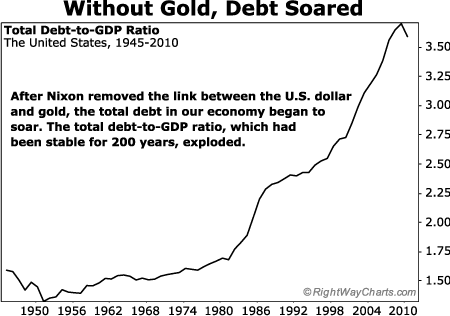
Steve's note: In yesterday's essay, my friend and colleague Porter Stansberry described
what he's calling "New American Socialism." Today, he explains where it began and how
it's changed the way he invests.
A warning before you read: Porter's views are controversial. And you may not agree with
everything he says. But I think it's worth your time to consider his argument…Why a Full-Scale Economic Collapse Is
InevitableBy Porter Stansberry Thursday, June 30, 2011 New American Socialism began with the policies of President Franklin Delano Roosevelt.
In 1933, FDR seized all the privately held gold in the U.S. and began creating the
massive government programs necessary to implement socialism. To give you some
idea of how much the federal government grew during FDR's reign, remember federal
spending made up 3% of GDP in 1930 – a level that had been fairly consistent for
most of America's history. Almost immediately after his election, he tripled federal
spending to more than 10% of GDP. And by the time he died in office, federal spending
reached 44% of GDP – an all-time high.
As everyone should know by now, the promises of socialism aren't affordable. Robbing
Peter to pay Paul is inefficient and kills Peter's incentives. The result is usually economic
stagnation, depression, and eventually a crisis that frees people from the government's
confiscatory repression.
Because America was the only large economy standing after World War II, it took much
longer than usual for the problems of socialism to appear in our economy. Also, the
government scaled back many of FDR's policies during the post-war boom. In winning
the war, we also won a generation of economic spoils.
All this changed in the 1960s.
Lyndon Johnson had delusions of government-led grandeur. His ideas of a "Great Society"
and "Model Cities," along with an expensive foreign war (Vietnam), were a recipe for
massive new debts and an increasing role for government in all aspects of American life.
These policies led to an acute funding problem in 1971, because the debts of socialism
couldn't be financed with gold-backed money. It was far too expensive. And so we began
a new kind of socialism… the New American Socialism.
What happened in 1971? The size of America's government deficits forced us to abandon
gold. After World War II, the U.S. dollar became the world's reserve currency. In exchange
for placing the dollar at the center of the world's economy, we made a solemn promise to
always exchange the U.S. dollar for gold at $35 an ounce.
Nixon broke that promise, calling our creditors "global speculators" and telling them to go
pound sand.
This move away from gold severed the fundamental tie between our economy and
our money. Without the link to gold, bank reserves could be created by fiat. And they
were. This led to a huge expansion of our money supply and our debts.
The power to use this debt and to control the creation of new money is the most powerful
factor in our economy. The government can now create unlimited amounts of credit to
control the U.S. economy. This bestows favored status on certain companies – notably
banks. This lies at the core of our economy's structure. It is how fiat money privatizes
the benefits of New American Socialism.
Most Americans simply don't understand our historic tie to gold made it impossible for
the banking system to grow beyond clear boundaries. Gold limited the amount of currency
in circulation, which, in turn, restricted how much money banks could lend. Under the gold
standard, the maximum total debt-to-GDP ratio was limited to around 150%. But as soon
as we broke the tie to gold, our total debt-to-GDP ratio began to grow. It's now close to
400%.
Without the tie to gold, the amount of economic mischief our government could engineer
became practically limitless. No social goal was too absurd… no war too expensive… and
no government insurance scheme too patently self-serving not to finance.
in that sector. Suddenly, businesses cannot function without massive government aid.
These corporate wards of the State weigh down the rest of our economy… making us
weaker and less competitive and dragging us further into debt.
Keep in mind, this New American Socialism I'm talking about isn't called socialism at all.
It goes by many names. It's been called "compassionate conservatism." It's been called
"joint public-private enterprise." It's been called "government insurance."
I've been studying it for many years – finding it in one company after another.
I've actually preferred having it in many of the stocks I've recommended
over the years because it tends to be good for investors.
That's the most insidious thing about New American Socialism: It's a form of socialism
that leaves the profit motive in place.
That's why the New American Socialism has grown decade after decade. That's why it
continues to be heavily promoted by almost every mainstream media outlet and both
political parties.
It leads to a kind of corruption I believe will be impossible to stop without a full-scale
economic collapse.
Regards,
Porter Stansberry
P.S. In tomorrow's essay, I'll show you an example of how New American Socialism
has taken over an entire sector of the economy… and how a kind of legal corruption
has allowed money to flow from the government into the pockets of well-placed executives
and companies.
Thursday, 30 June 2011
Posted by
Britannia Radio
at
14:29
![]()





















